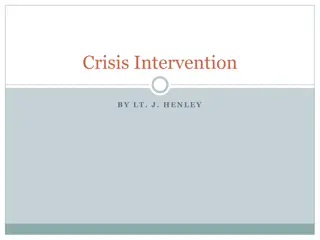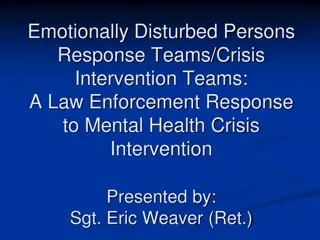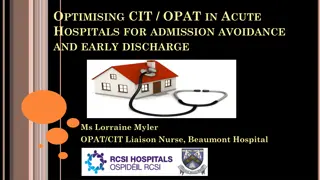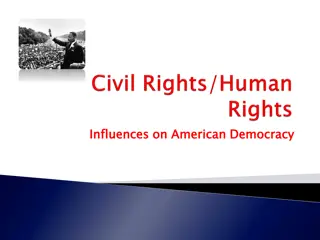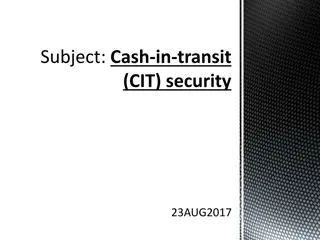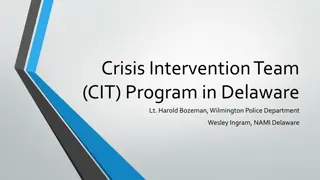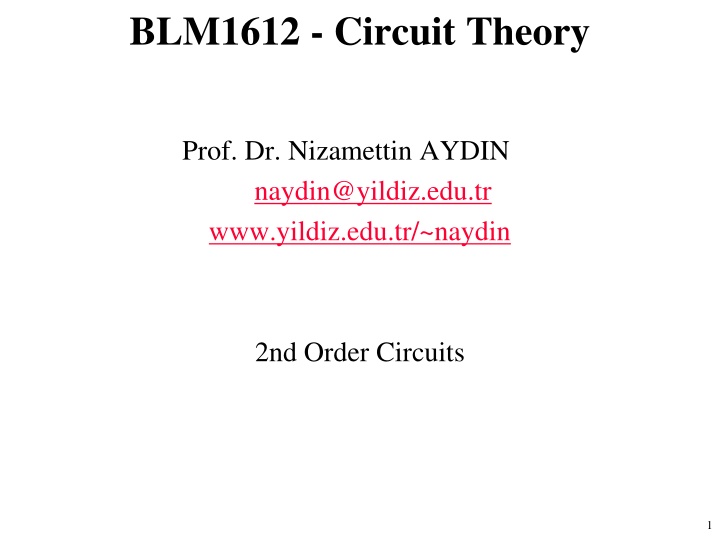
2nd Order Circuits: Boundary and Initial Conditions Explained
Explore the concepts of boundary conditions, initial conditions, and second-order circuits in circuit theory. Learn how to determine voltage and current conditions in a 2nd order circuit and their importance in calculating transient responses. Examples provided for practical understanding.
Download Presentation

Please find below an Image/Link to download the presentation.
The content on the website is provided AS IS for your information and personal use only. It may not be sold, licensed, or shared on other websites without obtaining consent from the author. If you encounter any issues during the download, it is possible that the publisher has removed the file from their server.
You are allowed to download the files provided on this website for personal or commercial use, subject to the condition that they are used lawfully. All files are the property of their respective owners.
The content on the website is provided AS IS for your information and personal use only. It may not be sold, licensed, or shared on other websites without obtaining consent from the author.
E N D
Presentation Transcript
BLM1612 - Circuit Theory Prof. Dr. Nizamettin AYDIN naydin@yildiz.edu.tr www.yildiz.edu.tr/~naydin 2nd Order Circuits 1
Objective of Lecture Demonstrate how to determine the boundary conditions on the voltages and currents in a 2nd order circuit. These boundary conditions will be used when calculating the transient response of the circuit. 3
2ndOrder Circuits A second-order circuit is characterized by a second-order differential equation. The circuit will contain at least one resistor and the equivalent of two energy storage elements 2 capacitors, 2 inductors, or a capacitor and an inductor 4
Boundary Conditions Steady state For step response functions u(t- to) for all times between t = +/- except for some time period after t = to Capacitors are open circuits Inductors are short circuits During the transition at the step t = to Voltage across a capacitor is continuous vC(to +) = vC(to -) Current through an inductor is continuous iL(to +) = iL(to -) 5
Initial Condition Redraw the circuit at t < to Determine the value of all voltage and current sources at t< to Make the appropriate substitutions for the energy storage devices. Substitute an open circuit ( resistor) for all capacitors. Note: IC(t < to ) = 0A. Substitute an short circuit (0 resistor) for all inductors. Note: VL(t < to ) = 0V. Calculate VC(t < to ) and IL(t < to ). 6
Final Condition Redraw the circuit at t = s Determine the value of all voltage and current sources at t = s Make the appropriate substitutions for the energy storage devices. Substitute an open circuit ( resistor) for all capacitors. Note: iC(t = s) = 0A. Substitute an short circuit (0 resistor) for all inductors. Note: vL(t = s) = 0V. Calculate vC(t = s) and iL(t = s). 7
Example 01 The switch in the circuit has been closed for a long time. It is open at t = t0. Find the Boundary Conditions iL, vL, iC, vC 8
Example 01 At the initial condition the circuit is: iL(- ) = iL(to-) = 0 A iC(- ) = iC(to-) = 0 A vL(- ) = vL(to-) = 0 V vC(- ) = vC(to-) = [R2/(R1+R2)]V1 9
Example 01 At the final condition the switch opens, which removes V1 and R1 from the circuit. The energy stored in the inductor and capacitor will be dissipated through R2 and R3 as t increased from t = to. R2 10
Example 01 At time t = s, the energy stored in the inductor and in the capacitor will be completely released to the circuit. iL( s) = 0 A vL( s) = 0 V iC( s) = 0 A vC( s) = 0 V For to< t << s iL(t) 0 A vL(t) 0 V iC(t) 0 A vC(t) 0 V 11
Example 02 The switch in the circuit has been closed for a long time. It is open at t = t0. Find the Boundary Conditions iL, vL, iC, vC 12
Example 02 t < to t >> to iL(- s) = 0.3 mA vL(- s) = 0 V iC(- s) = 0 A vC(- s) = 3.5 V iL( s) = 0 A vL( s) = 0 V iC( s) = 0 A vC( s) = 5 V 13
Example 03 The switch in the circuit has been open for a long time. It is open at t = t0. Find the Boundary Conditions iL1, vL1, iL2, vL2 14
Example 03 t < to iL1(- s) = -1 mA vL1(- s) = 0 V iL2(- s) = 1 mA vL1(- s) = 0 V 15
Example 03 t > to t >> to iL1( s) = -1 mA iL2( s) = 1.4 mA vL1( s) = 0 V vL2( s) = 0 V 16
Example 04 The switch in the circuit has been closed for a long time. It is closed at t = 0. Find the Boundary Conditions iL, vL, iC1, vC1, iC2, vC2 17
Example 04 t < 0 iL1(- s) = -1 mA vL1(- s) = 0 V iC1(- s) = iC2(- s) = 0 A vC1(- s) = vC2(- s) = 4 V 18
Example 04 t >> 0 iL1( s) = 0mA vL1( s) = 0V vC1( s) = vC2( s) = 1V iC1( s) = iC2( s) = 0A 19
Summary Calculation of the initial and final conditions for 2nd order circuits requires: Knowledge of the magnitude of the voltage and/or current sources in the circuit before and after a step function transition. In steady state (t < toand t = s), replace energy storage devices. Capacitors are opens circuits => iC= 0 A Inductors are short circuits => vL= 0 V Calculate the voltage across the capacitor and the current through the inductor. During the transition at the step t = to Voltage across a capacitor is continuous vC(to +) = vC(to -) Current through an inductor is continuous iL(to +) = iL(to -) 20
Source-Free RLC Circuit-Series RLC Network Objective of Lecture Derive the equations that relate the voltages across and currents flowing through a resistor, an inductor, and a capacitor in series as: the unit step function associated with voltage or current source changes from 1 to 0 or a switch disconnects a voltage or current source into the circuit. Describe the solution to the 2ndorder equations when the condition is: Overdamped Critically Damped Underdamped 21
Series RLC Network With a step function voltage source. 22
Boundary Conditions You must determine the initial condition of the inductor and capacitor at t < toand then find the final conditions at t = s. Since the voltage source has a magnitude of 0 V at t < to i(to-) = iL(to-) = 0 A and vC(to-) = Vs vL(to-) = 0 V and iC(to-) = 0 A Once the steady state is reached after the voltage source has a magnitude of Vs at t > to, replace the capacitor with an open circuit and the inductor with a short circuit. i( s) = iL( s) = 0 A and vC( s) = 0 V vL( s) = 0 V and iC( s) = 0 A 23
Selection of Parameter Initial Conditions i(to-) = iL(to-) = 0 A and vC(to-) = Vs vL(to-) = 0 V and iC(to-) = 0 A Final Conditions i( s) = iL( s) = 0A and vC( s) = 0 V vL( s) = 0 V and iC( s) = 0 A Since the voltage across the capacitor is the only parameter that has a non-zero boundary condition, the first set of solutions will be for vC(t). 24
Kirchhoffs Voltage Law = ( ) 0 v t ( ) di t + + = ( ) 0 L dt v t L Ri C L ( ) dv t = ( ) C dt i t C C = ( ) ( ) i t i t L C 2 ( ) ( ) d v t dv t + + = ( ) 0 C C dt LC RC v t C 2 dt ) 2 Second order Differential Equation ( ( ) 1 d v t dv t R + + = ( ) 0 C C dt v t C 2 dt ( L LC = ) ( when t ) v t t v t t t C o t o o 25
General Solution Let vC(t) = Aes t AR A + + = 2 s t s t s t 0 As e se e L LC 1 R + + = 2 s t ( ) 0 Ae s s L LC 1 R + + = 2 0 s s L LC 26
General Solution 1 R + + = 2 0 s s Characteristic Equation L LC 2 1 R 2 R 2 = + s 1 L L LC Roots of Characteristic Equation 2 1 R 2 R 2 = s 2 L L LC 27
General Solution A more compact way of expressing the roots: R 2 = + 2 2 o s = 1 L = 2 2 o s 1 2 = o LC + + = 2 2 o 2 0 s s The roots s1and s2are called natural frequencies, measured in nepers per second (Np/s), because they are associated with the natural response of the circuit; 0is known as the resonant frequency or strictly as the undamped natural frequency, expressed in radians per second (rad/s); is the neper frequency or the damping factor, expressed in nepers per second. 28
.General Solution = s t ( ) v t A e 1 1 C 1 = s t ( ) v t A e 2 2 ( 2 C = + = + s t s t ) ( ) ( ) v t v t v t A e A e 1 2 2 1 2 C C C 1 29
Solve for Coefficients A1and A2 Use the boundary conditions at to-and t = s to solve for A1 and A2. t v = ( ) V C o S Since the voltage across a capacitor must be a continuous function of time. t v t v + 2 1 + + + = = + = ( ) ( ) ( ) ( ) v t + v t V 1 2 C o C o C A o C V o S ( ) ( ) = = 0 0 s s s s A e A e A 1 2 1 2 S Also know that ( ) dv t d = = + = ( ) ( ) ( ) 0 C o i t C v t v t 1 2 C o C o C o dt dt ( ) ( ) + = + = 0 0 s s s s 0 s A e s A e s A s A 1 2 1 1 2 2 1 1 2 2 30
Three types of solutions From these equations, we can infer that there are three types of solutions: If , we have the overdamped case. If = , we have the critically damped case. If , we have the underdamped case. We will consider each of these cases separately. 31
Three types of solutions Overdamped Case ( ) implies that C > 4L/R2 s1and s2are negative and real numbers s C e A t v = 1 ) ( v(t) + t s t A e 1 2 2 Critically damped Case ( = ) implies that C = 4L/R2 s1= s2= - = -R/2L e A t v = 1 ) ( v(t) + t t A te 2 C 32
Three types of solutions Underdamped Case ( ) implies that C < 4L/R2 v(t) = + = + j 2 2 o s 1 d = = j 2 2 o s 2 d = 2 o 2 d , i is used by the mathematicians for imaginary numbers = 1 j 33
Three types of solutions = + j t j t t ( ) ( ) v t e A e A e d d 1 2 C = + j cos = sin e j j cos sin e j = + + t ( ) [ (cos + sin ) (cos sin )] v t e A t j t A t j t 1 2 C d d d d = + t ( ) [( ) cos ( ) sin ] v t e A A t j A A t 1 2 1 t 2 C d d = + t ( ) [ cos sin ] v t e B t B 1 2 C d d = + = B A A ( ) B j A A 1 1 2 2 1 2 34
Angular Frequencies ois called the undamped natural frequency The frequency at which the energy stored in the capacitor flows to the inductor and then flows back to the capacitor. If R = 0 , this will occur forever. dis called the damped natural frequency Since the resistance of R is not usually equal to zero, some energy will be dissipated through the resistor as energy is transferred between the inductor and capacitor. determined the rate of the damping response. 35
Properties of RLC network Behavior of RLC network is described as damping, which is a gradual loss of the initial stored energy The resistor R causes the loss determined the rate of the damping response If R = 0, the circuit is loss-less and energy is shifted back and forth between the inductor and capacitor forever at the natural frequency. 37
Properties of RLC network Oscillatory response of a lossy RLC network is possible because the energy in the inductor and capacitor can be transferred from one component to the other. Underdamped response is a damped oscillation, which is called ringing. Critically damped circuits reach the final steady state in the shortest amount of time as compared to overdamped and underdamped circuits. However, the initial change of an overdamped or underdamped circuit may be greater than that obtained using a critically damped circuit. 38
Set of Solutions when t > to There are three different solutions which depend on the magnitudes of the coefficients of the and the terms. ) (t vC dt dvC ) ( t To determine which one to use, you need to calculate the natural angular frequency of the series RLC network and the term . 1 = o LC R 2 = L 39
Transient Solutions when t > to Overdamped response ( > o) t t = where = + s t s t ( ) v t A e A e 1 2 1 2 C ot = + 2 2 0 s 1 = 2 2 0 s 2 Critically damped response ( = o) = + t ( ) ( ) v t A A t e 1 2 C Underdamped response ( < o) = = + t ( ) [ cos( ) sin( )] v t B t B t e 1 2 C d d 2 = + = 2 , , 2 A ( ) B A B j A A 1 1 2 1 2 d o 40
Find Coefficients After you have selected the form for the solution based upon the values of oand Solve for the coefficients in the equation by evaluating the equation at t = to-and t = s using the initial and final boundary conditions for the voltage across the capacitor. vC(to-) = Vs vC( s) = 0 V 41
Other Voltages and Currents Once the voltage across the capacitor is known, the following equations for the case where t > to can be used to find: ( ) dv t = ( ) C i t C C dt = = = ( ) ( ) di ( ) ( ) i t i t i t i t C L R ( ) t = ( ) L v t L L dt = ( ) ( ) v t Ri t R R 42
Solutions when t < to The initial conditions of all of the components are the solutions for all times - s < t < to. vC(t) = Vs iC(t) = 0 A vL(t) = 0 V iL(t) = 0 A vR(t) = 0 V iR(t) = 0 A 43
Summary The set of solutions when t > to for the voltage across the capacitor in a RLC network in series was obtained. Selection of equations is determine by comparing the natural frequency oto Coefficients are found by evaluating the equation and its first derivation at t = to-and t = s. The voltage across the capacitor is equal to the initial condition when t < to Using the relationships between current and voltage, the current through the capacitor and the voltages and currents for the inductor and resistor can be calculated. 44
Source-Free RLC Circuit-Parallel RLC Network Objective of Lecture Derive the equations that relate the voltages across and currents flowing through a resistor, an inductor, and a capacitor in parallel as: the unit step function associated with voltage or current source changes from 1 to 0 or a switch disconnects a voltage or current source into the circuit. Describe the solution to the 2ndorder equations when the condition is: Overdamped Critically Damped Underdamped 45
RLC Network A parallel RLC network where the current source is switched out of the circuit at t = to. 46
Boundary Conditions You must determine the initial condition of the inductor and capacitor at t < toand then find the final conditions at t = s. Since the voltage source has a magnitude of 0V at t < to iL(to-) = Is and v(to-) = vC(to-) = 0 V vL(to-) = 0V and iC(to-) = 0 A Once the steady state is reached after the voltage source has a magnitude of Vs at t > to, replace the capacitor with an open circuit and the inductor with a short circuit. iL( s) = 0A and v( s) = vC( s) = 0 V vL( s) = 0V and iC( s) = 0 A 47
Selection of Parameter Initial Conditions iL(to-) = Is and v(to-) = vC(to-) = 0 V vL(to-) = 0V and iC(to-) = 0 A Final Conditions iL( s) = 0A and v( s) = vC( s) = 0 V vL( s) = 0V and iC( s) = 0 A Since the current through the inductor is the only parameter that has a non-zero boundary condition, the first set of solutions will be for iL(t). 48
Kirchoffs Current Law + + = ( t ) ( ) ( ) t 0 i t i t i t R L C = = = ( ) ( ) ( ) ( ) v v t v v t R L C ( ) ( ) dv t v t + + = ( ) 0 C R i t C L R dt ( ) di t = = ( ) ( ) L v t v t L L dt 2 ( 2 ) ( ) d i t L di t + + = ( ) 0 L L LC i t L dt R dt 2 ( 2 ) 1 ( ) ( ) d i t di t i t + + = 0 L L L dt RC dt LC 49
General Solution 1 1 + + = 2 0 s s RC LC 2 1 1 1 = + s 1 2 2 RC RC LC 2 1 1 1 = s 2 2 2 RC RC LC 50

